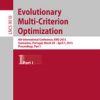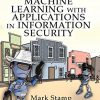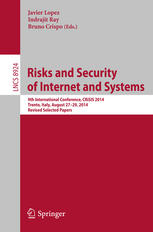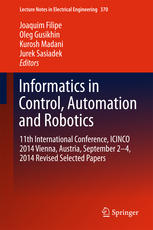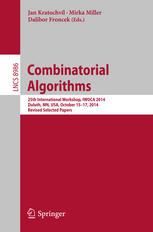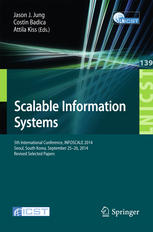Augmented and Virtual Reality First International Conference AVR 2014 Lecce Italy September 17 20 2014 Revised Selected Papers 1st by Paolis Mongelli 3319139681 9783319139685
$50.00 Original price was: $50.00.$25.00Current price is: $25.00.
Augmented and Virtual Reality First International Conference AVR 2014 Lecce Italy September 17 20 2014 Revised Selected Papers 1st by Paolis Mongelli – Ebook Instant Download/Delivery ISBN:3319139681 , 9783319139685
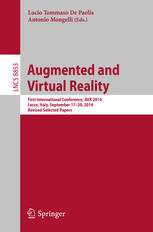
Product details:
Table of contents:
1 Introduction
1.1 Background and Motivation
2 Related Work
2.1 Development and Application of Augmented Reality
2.2 Analyses and Discussions
3 System Overview
4 Results and Discussions
4.1 Structure and Process
4.2 Development Tools
4.3 The Development Flow
5 Conclusions
References
Investigation on Player and Virtual Environment Interaction
1 Introduction
2 Virtual Environment – “Spaceship” Computer Game
3 Experiment and Data
3.1 Sample
3.2 Psychological Tests and Data Collection
3.3 Stages of the Experiment
3.4 Emotional and Game-play Data Processing
4 Results
4.1 Impact of Computer Game on Player
4.2 Player’s Contribution to Gaming Experience
5 Conclusions and Discussion
References
Real-Time Single Camera Hand Gesture Recognition System for Remote Deaf-Blind Communication
1 Introduction
2 Related Works
2.1 Hand Tracking
2.2 Anthropomorphic Haptic Interfaces
2.3 Transmission
3 The Developed Solution
3.1 The Input Module
3.2 The Transmission Module
3.3 The Robotic Hand Module
3.4 Implementation of the System
4 Experimental Results
4.1 Input Module Validation
4.2 Experimental Method
5 Conclusions
References
Measuring the Student’s Success Rate Using a Constraint Based Multi-modal Virtual Assembly Environme
1 Introduction
2 Related Work
3 Virtual Reality Training System
3.1 Software Architecture of VRTS
4 Experiments and Evaluation
4.1 Protocol and Task
5 Result Analysis
6 Conclusion and Future Work
References
The Effect of Multimodal Virtual Chemistry Laboratory on Students’ Learning Improvement
1 Introduction
2 Literature Review
3 Multimodal Virtual Laboratory (MMVL)
3.1 Software Architecture
4 Experiments and Evaluations
4.1 Experimental Setup
4.2 Experimental Protocol and Task
4.3 Analysis
Statistical and Subjective Assessment.
5 Conclusion
References
Medicine
Virtual Reality Surgical Navigation System for Holmium Laser Enucleation of the Prostate
1 Introduction
2 Materials and Methods
2.1 Prototypal System Architecture
2.2 Phantoms (Feasibility Study)
3 Results
4 Conclusions
References
Development of a Serious Game for Laparoscopic Suture Training
1 Introduction
2 Surgical Training
3 Virtual Surgical Simulators
4 Serious Games
5 Technological Platform
6 Simulation Models
7 Serious Game for Laparoscopic Suturing Training
8 Conclusions and Future Work
References
A Method of Three-Dimensional Visualization of Molecular Processes of Apoptosis
1 Introduction
2 Basic Features of CellML and OpenCell
3 Apoptosis Models Based on CellML
4 3D Visualization of the CellML Models of Apoptosis
5 Conclusions
References
AGITO: Virtual Reality Environment for Power Systems Substations Operators Training
1 Introduction
2 Related Works
3 Background
3.1 Open Supervisory and Control System (SAGE)
3.2 Simulop
4 Proposed System
4.1 AgitoServer – Interoperation Layer
4.2 AgitoViewer – Client Layer
4.3 AgitoSupervisor
5 Discussion and Future Works
References
Lossless Compression of Multidimensional Medical Images for Augmented Reality Applications
1 Introduction
2 A Predictive Structure for Multidimensional Data
3 Experimental Results
3.1 3-D Medical Images
3.2 5-D Functional Magnetic Resonance Images
4 Conclusions and Future Work
References
Low-Cost Motion-Tracking for Computationa lPsychometrics Based on Virtual Reality
1 Introduction
2 A New Platform for Assessment and Neurorehabilitation:Neuro Virtual 3D
2.1 Microsoft Kinect-Neuro Virtual 3D Interaction Interface: Technical Features
3 The Potentiality of Neuro Virtual 3D for Psychology
References
Augmented and Mixed Reality
A Design and Evaluation Framework for a Tele-Immersive Mixed Reality Platform
1 Introduction
2 Background
3 3D-LIVE Design Process and Evaluation Model
4 Observational Methodology
5 Preliminary Results
6 Conclusion
References
Hand Orientation Regression Using Random Forest for Augmented Reality
1 Introduction
1.1 Our Contribution
2 Method
2.1 Feature Extraction
2.2 Dimensionality Reduction
2.3 Ground Truth (GT) Data Generation Using Depth Maps
2.4 Training Using Random Forest
3 Experimental Evaluation
3.1 Single Fold Validation
3.2 Leave-One-Out Cross-Validation
4 Discussion
5 Application to Augmented Reality
6 Conclusion
References
Visualization of Power Systems Based on Panoramic Augmented Environments
1 Introduction
2 Power System – Panoramic Augmented Environment (PS-PAE)
2.1 Power System Data Acquisition
2.2 Panoramic Viewer
3 Conclusion and Future Works
References
A Workflow Analysis for Implementing AR-Based Maintenance Procedures
1 Introduction
2 Background
3 The Workflow
3.1 Tracking Process
2D Image Tracking.
3D Map Tracking.
3D CAD Tracking.
3.2 Workflow Implementation: A Case Study
Workflow Diagram.
Defining the Procedure Steps.
Choosing the Object to Track.
Testing the Tracking Systems.
Modeling the Object.
Creating the Assets.
Creating the Application with Metaio Creator.
4 Tests
5 Conclusions
References
Augmented Reality at the Industrial Shop-Floor
1 Introduction
2 Approach for Implementing Augmented Reality
3 Equipment
4 Experiment
5 Results
6 Conclusions and Future Work
References
Robust Global Tracking Using a Seamless Structured Pattern of Dots
1 Introduction
2 Related Work
3 Structured Dot Marker
4 Tracking
4.1 Image Capture
4.2 Dot Detection
4.3 Line Detection
4.4 Line Identification
4.5 Point Identification
4.6 Optical Flow Tracking
4.7 Pose Estimation
5 Results
5.1 Virtual Setup
5.2 Real World Setup
5.3 Increasing Tracking Distance
5.4 Robustness
5.5 Number of Lines
5.6 Processing Time
5.7 Comparative Analysis
6 Applications
7 Conclusion
References
Lightweight Augmented Reality Tools for Lean Procedures in Future Factories
1 Introduction
2 Augmented Reality: Technology Overview
3 AR for Visual Factories
4 AR Tools on the Field
4.1 The System Architecture
4.2 Augmented Reality Tools for Sofas Production Support
4.3 AR Assisted Picking Procedure
4.4 Augmented Reality Tools for Production Progress Control
5 Conclusions and Future Works
References
Interactive Augmented Omnidirectional Video with Realistic Lighting
1 Introduction
2 Previous Work
3 Our Approach
3.1 ODV Capturing and Rendering
3.2 Camera Tracking Using Structure From Motion
3.3 Real-Time Augmented Rendering
4 Results
5 Conclusion
References
Cultural Heritage
Natural Interaction and Wearable Augmented Reality for the Enjoyment of the Cultural Heritage in Out
1 Introduction
2 Related Work
3 System Description
3.1 Goals and Motivation
3.2 Visual Augmentation
3.3 Depth Sensing
3.4 Tracking
4 User Interface Description
5 Design and Implementation Details
6 Lessons Learned
7 Conclusions and Future Work
References
Virtual Reality Visualization for Photogrammetric 3D Reconstructions of Cultural Heritage
1 Introduction
2 The Visualization System “Kyb3”
2.1 Design Choices of the Kyb3 Related to Space
2.2 Design Choices of the Kyb3 Related to Budget
3 Application Within Cultural Heritage
4 3D Scanning with a Depth Sensor
5 Photogrammetric Reconstruction
5.1 123D Catch
5.2 Python Photogrammetry ToolBox
5.3 VisualSFM
6 BlenderCAVE
7 Conclusions and Outlook
References
Augmented Reality for Allowing Time Navigationin Cultural Tourism Experiences: A Case Study
1 Introduction
2 Architecture and Data Model
3 Validation Scenario
4 Related Work
5 Conclusions and Future Work
References
Easy Perception Lab: Evolution, Brainand Virtual and Augmented Realityin Museum Environment
1 Introduction
2 Method
2.1 Behavioral Tools
2.2 Psychophysiological Tools
2.3 Conditions of Registration
2.4 First Experiment
2.5 Data Analysis
2.6 Second Experiment
2.7 Data Analysis
3 Conclusions and Discussion
References
Visualization and 3D Modelling
On-Demand Generation of 3D Content Based on Semantic Meta-Scenes
1 Introduction
2 Related Works
2.1 Semantic Modeling of 3D Content
2.2 Adaptation of 3D Content
2.3 Query Languages for Web Content
3 The Semantic Content Model
4 The Content Generation Method
4.1 Content Selection
Explicit Selection of Presentable Objects.
Implicit Selection of Presentable Objects.
4.2 Content Projection
Choice of Properties and Relations.
4.3 Content Extension and Composition
Explicit Content Modification.
Implicit Content Modification.
5 An Example On-Demand 3D Content Generation
6 Implementation
7 Conclusions and Future Works
References
Moka: Designing a Simple Scene Graph Library for Cluster-Based Virtual Reality Systems
1 Introduction
2 Cluster Rendering Approaches
2.1 Input Event Distribution
2.2 Graphics Command Distribution
2.3 Scene Graph Distribution
3 Motivations
4 The Moka Library
4.1 The Basic Scene Graph
4.2 Distributing the Scene Graph
4.3 The Distributed Objects Registry
4.4 Network Communication
4.5 Animations
4.6 Procedurally Generated Geometry
4.7 Local Sub-graphs
4.8 Hot-Plug Synchronization
4.9 Application Level Distributed Objects
4.10 Configuration Tools
5 Caffeine
5.1 GPU-Accelerated Visualization of Molecular Structures
5.2 A First Qualitative Performance Evaluation
6 Conclusions and Future Work
References
Stereoscopic-3D Vision to Improve Situational Awareness in Military Operations
1 Introduction
2 Stereoscopic 3D Visualization
3 Related Works
4 Proposed Investigation
4.1 High-Level Architecture of LOKI
4.2 Design Choices for the UI
5 Experimental Design and Test Procedure
5.1 Hardware and Software Choices
5.2 Usability Evaluation
5.3 Results Analysis
6 Conclusion
References
Roll and Pitch Estimation Using Visual Horizon Recognition
1 Introduction
1.1 Related Works
2 Attitude Parameters Extraction by Single Camera
2.1 Automatic Horizon Recognition
2.2 Algorithm for Roll and Pitch Evaluation
3 Experimentation Approach
3.1 Field Test Description
3.2 Photogrammetry Approach
3.3 INS with ZUPT Approach
3.4 Horizon Approach
4 Results, Comparisons and Analyses
4.1 Clear Scenario
4.2 Hostile Scenario
5 Conclusions and Future Developments
References
3D Model Visualization and Interaction Using a Cubic Fiducial Marker
1 Introduction
2 Related Work
3 Proposed System
4 Experimental Design
5 System Evaluation
5.1 3D Model Visualization
5.2 Marker Occlusion
5.3 Marker Rotation
6 Conclusion and Future Work
References
Posters
Intuitive Visualization of Reflectance Transformation Imaging for Interactive Analysis of Cultural A
1 Introduction
2 Background and Related Work
3 Technical Approach
3.1 Data Preparation
3.2 Input Components
3.3 Collaborative Lighting Control Server
3.4 Rendering Components
4 Usage Examples and Benefits
5 Conclusion and Future Research
References
Euclidean Vectors in Physics Education Using Augmented Reality
1 Introduction
2 Methods
2.1 System Setup
2.2 User Interface
3 Preliminary Results
4 Discussion
5 Conclusion
References
SLAM Map Application for Tracking Lights on Car Dashboards
1 Introduction
2 Background Information
3 System Overview
3.1 Training
3.2 Detection
4 Experiments and Results
5 Conclusions and Future Works
References
A Live Augmented Reality Tool for Facilitating Interpretation of 2D Construction Drawings
1 Introduction
2 Method
2.1 Hardware
2.2 Software
2.3 Model
2.4 System Design
2.5 Tests
3 Results
4 Conclusion
References
Augmented Reality Simulator for Laparoscopic Cholecystectomy Training
1 Introduction
2 Material and Methods
2.1 Physical Components
2.2 AR Functionality
2.3 Acoustic Functionality
3 Preliminary Results
4 Future Work and Conclusion
References
Tile Tracker: A Practical and Inexpensive Positioning System for Mobile AR Applications
1 Introduction
2 Overview of Our Approach
3 Marking
3.1 Why Ground Tiles?
3.2 Marker Design
3.3 Determining the Match
4 Frame Processing
4.1 Binarization
4.2 Segmentation and Contour Detection
4.3 Corner Extraction
5 Camera Calibration
6 Discussion
7 Conclusion
References
Designing an Interactive and Augmented3D Environment with Passive Tactile Feedback for Veterinary T
1 Introduction
2 Problem Area and Global Practice in Anatomy Training
3 Design and Composition of AR Training Environment
4 Contents Preparation for AR Training
5 Implementation of Augmented Skeleton and Exhibit Intelligence
6 Conclusions
References
Investigation on Human Attentiveness to Video ClipsUsing Neurosky and LIRIS-ACCEDE Database
1 Introduction
2 Software for Emotion Elicitation
3 Experiment and Data
4 Results
5 Conclusions and Future Work
References
Virtual Acoustic Reconstruction of the Church at the Lost Monastery of Santa Maria de la Murta
1 Introduction
1.1 Brief Historical Notes
1.2 Architecture of the Lost Monastery
2 Methodology of the Virtual Acoustic Rehabilitation of the New Church of the Monastery
3 Results and Discussion
4 Auralization of a Musical Excerpt
5 Conclusions and Future Work
People also search:
augmented and virtual reality in healthcare
augmented reality intern
the future of virtual and augmented reality in business
virtual and augmented reality technologies
augmented reality first invented
You may also like…
Computers - Computer Science
Computers - Computer Science Computers - Cryptography
Science (General)


